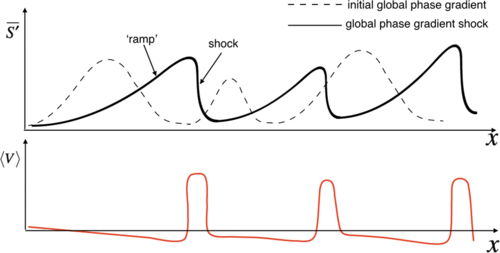

主要从事等离子体物理理论研究,特别是磁约束聚变等离子体物理。
(1)将非线性相动力学理论引入到磁约束等离子体边界物理研究, 提出了无崩塌型高约束模式形成机制的新理论。
高约束模式(H 模)是磁约束聚变反应堆实现自持聚变的基本运行模式。通常的 H 模总是伴随着边界的周期性崩塌过程(ELM),其所释放的热流强度往往过大(>100MW/m^2),远超目前磁约束装置材料所能承受的热负荷极限 (~10MW/m^2)。因此,缓解或消除 ELM 是当前磁约束聚变研究的一个迫切问题。QH 模(Q:quiescent)是近年国内外各主要托卡马克装置陆续发现的无ELM高约束模式。由于QH 模既有与 ELM 相当的杂质排除能力,又能大幅度降低装置受到的瞬间热负荷,因此其成为磁约束装置长脉冲运行的一个理想选择。我们首次提出研究等离子体边界区磁流体(MHD)模式的涡旋波耦合理论,并发现径向电场曲率在 QHàELM H模转化过程起着关键作用。通过增加边界电场曲率,可以将‘爆炸式’MHD模式转化成高频、良性MHD模式,从而避免破裂型ELM的发生。这一最新理论进展对当前的高参数磁约束聚变实验具有重要指导意义。相关结果发表在《物理评论快报》上(Y. Zhang, Z. B. Guo*, and P. H. Diamond,125, 255003, (2020));
(2)基于非线性相动力学理论,提出带状流激发的一个内禀机制,即调频机制。
带状流在抑制等离子体湍流反常输运方面起着关键作用,其存在性已经被大量物理实验和数值模拟所证实。但关于带状流产生机制的理论研究主要围绕各种调幅不稳定性展开,这与实验、模拟中所发现的带状流具有内禀结构不符,因为调幅机制产生的带状流结构主要由初始条件决定。我们提出了带状流产生的新机制,即调频(或调相)机制。这一理论的核心是不同位置处激发模式的相位通过环向效应实现协同耦合,从而自发产生带状流。通过调频机制产生的带状流的频率、模结构由系统自身参数决定,与初始条件无关。这一新机制也在北京大学直线磁约束装置上得到了实验验证。相关理论结果发表在《物理评论快报》上(Z. B. Guo*, and P. H. Diamond,Physical Review Letters, 117, 125002, (2016))。

Figure 1: Red: phase lattice; dashed black: continuous limit of the phase lattice.

Figure 2: Top figure: global phase gradient shock induced by magnetic toroidicity;
bottom figure: staircaselike ZF bands induced by the shocks.
